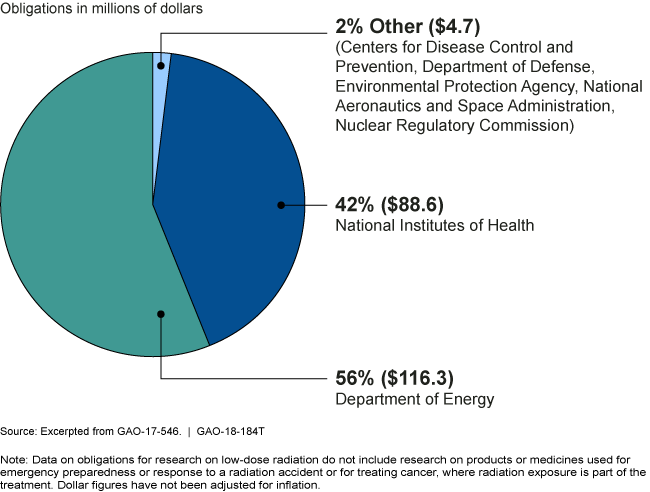Low-Dose Radiation: Interagency Collaboration on Planning Research Could Improve Information on Health Effects
Fast Facts
Federal agencies have established requirements to protect workers and the public against cancer and other harmful effects associated with low doses of radiation exposure. We testified that federal agencies have generally used the advice of scientific advisory bodies to develop and apply these requirements.
Additionally, for fiscal years 2012 through 2016, the Department of Energy and other federal agencies obligated about $210 million for research on the health effects of radiation. In the report on which this testimony is based, we recommended that Energy lead efforts to enhance interagency collaboration on this research.
Obligations for Research on Health Effects of Low-Dose Radiation, by Federal Agency, for Fiscal Years 2012-2016

Pie chart showing that the Department of Energy provided 56 percent of the obligations for low-dose radiation research.
Highlights
What GAO Found
The Department of Energy (DOE), Nuclear Regulatory Commission (NRC), Environmental Protection Agency (EPA), and Food and Drug Administration generally used the advice of scientific advisory bodies to develop and apply radiation protection requirements and guidance for workers and the public in the radiation exposure settings that GAO reviewed. These settings were: (1) the operation and decommissioning of nuclear power plants; (2) the cleanup of sites with radiological contamination; (3) the use of medical equipment that produces radiation; and (4) accidental or terrorism-related exposure to radiation. Specifically, the agencies relied on the advice of three scientific advisory bodies that supported the use of a model that assumes the risk of cancer increases with every incremental radiation exposure. Accordingly, the agencies have set regulatory dose limits and issued guidance to confine exposure to levels that reduce the risk of cancer, while recognizing that scientific uncertainties occur in estimating cancer risks from low-dose radiation. For example, NRC requires nuclear power plants to consider measures for limiting workers' exposure below NRC's regulatory dose limit, such as by using robots for maintenance work in radiation areas.
GAO identified seven federal agencies that funded research on low-dose radiation's health effects. In fiscal years 2012 to 2016, DOE, NRC, EPA, and four other federal agencies obligated about $210 million for such research (see table). Although the agencies have collaborated on individual projects on radiation's health effects, they have not established a collaborative mechanism to set research priorities. GAO's previous work has shown that federal agencies can use such mechanisms to implement interagency collaboration to develop and coordinate sound science policies. In the past, DOE took a leading role in this area because DOE provided stable funding and advocated for greater coordination on research on low-dose radiation's health effects. However, since fiscal year 2012, DOE has phased out funding for one of its main research programs in this area. This has created a void in coordination efforts among federal agencies, and no other agency has stepped forward to fill this void. Because of DOE's prior experience as a leader in this area of research and its research responsibility under the Atomic Energy Act of 1954, it could play an important role in helping federal agencies establish a coordinating mechanism for low-dose radiation research.
Federal Funding for Research on Low-Dose Radiation's Health Effects
Dollars are in millions and have not been adjusted for inflation
|
Agency |
Funding, fiscal years 2012–2016 |
|
Department of Energy |
116.3 |
|
National Institutes of Health |
88.6 |
|
Nuclear Regulatory Commission |
2.6 |
|
National Aeronautics and Space Administration |
1.0 |
|
Department of Defense |
0.4 |
|
Centers for Disease Control and Prevention |
0.4 |
|
Environmental Protection Agency |
0.3 |
|
Total |
209.6 |
Source: GAO analysis of agency data. | GAO-17-546
Why GAO Did This Study
This testimony summarizes the information contained in GAO's September 2017 report, entitled Low-Dose Radiation: Interagency Collaboration on Planning Research Could Improve Information on Health Effects (GAO-17-546).
For more information, please contact John Neumann at (202) 512-3841 or neumannj@gao.gov.
